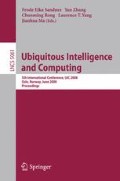Abstract
This paper presents a ubiquitous and robust text-independent speaker recognitionarchitecture for home automation digital life. In this architecture, a multiple microphone configuration is adopted to receive the pervasive speech signals. The multi-channel speech signals are then added together with a mixer. In a ubiquitous computing environment, the received speech signal is usually heavily corrupted by background noises. An SNR-aware subspace speech enhancement approach is used as a pre-processing to enhance the mixed signal. Considering the text-independent speaker recognition, this paper applies a multi-class support vectors machine (SVM)[10][11] instead of conventional Gaussian mixture models (GMMs)[12]. In our experiments, the speaker recognition rate can averagely reach 97.2% with the proposed ubiquitous speaker recognitionarchitecture.
Access this chapter
Tax calculation will be finalised at checkout
Purchases are for personal use only
Preview
Unable to display preview. Download preview PDF.
References
Cortes, C., Vapnik, V.: Support vector networks. Machine Learning 20, 273–297 (1995)
Vapnik, V.: The Nature of Statistical Learning Theory. Springer, New York (1995)
Vapnik, V.: Statistical Learning Theory. Wiley, New York (1998)
Schölkopf, B., Mika, S., Burges, C., Knirsch, P., Müller, K.-R., Rätsch, G., Smola, A.: Input space vs. feature space in kernel-based methods. IEEE Transactions on Neural Networks 10(5), 1000–1017 (1999)
Ephraim, Y., Van Trees, H.L.: A signal subspace approach for speech enhancement. IEEE Transactions on Speech and Audio Processing 3(4), 251–266 (1995)
Jia-Ching, W., Hsiao-Ping, L., Jhing-Fa, W., Chung-Hsien, Y.: Critical Band Subspace-Based Speech Enhancement Using SNR and Auditory Masking Aware Technique. IEICE Transactions on Information and Systems E90-D(7), 1055–1062 (2007)
Hui-Ling, H., Fang-Lin, C.: ESVM: Evolutionary support vector machine for automatic feature selection and Classification of micro array data. BioSystems 90, 516–528 (2007)
Shung-Yung, L.: Efficient text independent speaker recognition withwavelet feature selection based multilayered neural network using supervised learning algorithm. Pattern Recognition 40, 3616–3620 (2007)
Shung-Yung, L.: Wavelet feature selection based neural networks with application to the text independent speaker identification. BioSystems 90, 516–528 (2007)
Vincent, W., Steve, R.: Speaker verification using sequence discriminant support vector machines. IEEE transactions on speech and audio processing 13(2) (March 2005)
Campbell, W.M., Campbell, J.P., Gleason, T.P., Reynolds, D.A., Shen, W.: Speaker Verification Using Support Vector Machines and High-Level Features. IEEE transactions on speech, audio and language processing 15(7) (September 2007)
Burget, L., Matĕjka, P., Schwarz, P., Glembek, O., Cĕrnocký, J.H.: Analysis of Feature Extraction and Channel Compensation in a GMM Speaker Recognition System. IEEE transactions on speech, audio and language processing 15(7), 1979–1985 (2007)
Rabiner, L.R., Schafer, R.W.: Digital Processing of Speech Recognition Signals. Prentice-Hall Co. Ltd, Englewood Cliffs (1978)
Huang, X., Acero, A., Hon, H.: Spoken Language Processing: A Guide to Theory, Algorithm and System Development. Prentice-Hall Co. Ltd, Englewood Cliffs (2001)
Author information
Authors and Affiliations
Editor information
Rights and permissions
Copyright information
© 2008 Springer-Verlag Berlin Heidelberg
About this paper
Cite this paper
Wang, JF., Kuan, TW., Wang, Jc., Gu, GH. (2008). Ubiquitous and Robust Text-Independent Speaker Recognition for Home Automation Digital Life. In: Sandnes, F.E., Zhang, Y., Rong, C., Yang, L.T., Ma, J. (eds) Ubiquitous Intelligence and Computing. UIC 2008. Lecture Notes in Computer Science, vol 5061. Springer, Berlin, Heidelberg. https://doi.org/10.1007/978-3-540-69293-5_24
Download citation
DOI: https://doi.org/10.1007/978-3-540-69293-5_24
Publisher Name: Springer, Berlin, Heidelberg
Print ISBN: 978-3-540-69292-8
Online ISBN: 978-3-540-69293-5
eBook Packages: Computer ScienceComputer Science (R0)

